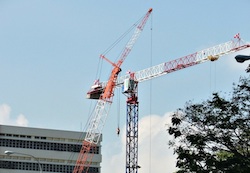 With sustainability, corporate social responsibility and recycling high on the agenda in a world of diminishing natural resources, the decision as to whether to demolish a building and start again should not be taken lightly.
With sustainability, corporate social responsibility and recycling high on the agenda in a world of diminishing natural resources, the decision as to whether to demolish a building and start again should not be taken lightly.
In weighing up the pros and cons, it would be unwise to only consider the building fabric; a much more holistic approach is advised. So what are the key questions to ask when planning commercial property refurbishment strategy?
Where is the property?
Unless the property is in a desirable location there is no point recommending either refurbishment or demolition and rebuilding. It may be a hackneyed phrase but ‘location, location, location’ is the first and foremost consideration for occupiers. No matter what is done to the outside or inside of a building, if it is in the wrong location it will not let.
This does not just cover the location of a town or city but the micro-location of the building and its surrounding area. Kerb appeal applies as much to commercial as it does to residential and first impressions are key.
What is the market like?
The law of supply and demand is very live to economic viability; if the location works, the next consideration should be the amount of existing built stock, other construction or refurbishments in the pipeline, plus associated completion dates to establish a baseline of competing supply.
This is then overlaid with the demand profile: what is the typical take up in the market? What are the level of lease breaks and expiries and general level of economic prosperity in the area? What are the chances of letting in a reasonable time frame? Even the most architecturally pleasing refurbishment can develop into a white elephant if the timing of delivery is wrong.
How obsolete is the existing building?
This influences the level of work required to meet the demands of modern building regulations in terms of energy performance, toilet provision, and occupational desire in terms of layout of floor plates, and ability to improve arrival experience.
For example, requirements for ambulant toilet provision in a building built at a time when it was not obligatory will mean a reduction in the net floor area in order to accommodate the requirements.
How high?
Building fundamentals matter – regardless of the location and supply. If the property has limited floor to ceiling height – “slab to slab” – of less than 2.7 metres and no raised floors, this will seriously call into question the ability to deliver an end product that is desirable to occupiers. All may not be lost, however, as the building may be a contender in this instance for conversion to residential through permitted development rights.
What is the planning policy?
Is the building in a conservation zone or listed? Research may govern the approach as the amount of work that can be undertaken may be limited or be met with local objections.
How well parked is the building?
An existing building with a good car parking ratio has to be in good contention for comprehensive refurbishment over redevelopment due to the planning constraints imposed by new planning rules and requirements.
How sustainable can you be?
Environmental Performance plays its part. BREEAM ratings are vastly improved by re-utilisation of the existing frames of building. BREEAM scoring systems are weighted to refurbishment over rebuilding with points awarded for both reuse of the building’s frame and the façade.
How much?
Up to 30 per cent of constructions costs can be below ground, added to construction of the frame of the building. Significant savings can be made on construction costs by refurbishing buildings with limited difference in rent and letting prospects – provided the fundamentals mentioned above are right.
It’s all in the timing
A comprehensive refurbishment can be delivered to the market in vastly improved timescales versus new-build, taking up to six months less. The ability to deliver product to the market much more quickly can make the difference between a scheme succeeding or failing.
What about industrial?
In addition to the fundamentals of location as detailed above, key considerations are the eaves’ height of the building and floor loading of the slab. Industrial buildings by their very nature and certainly if constructed of steel portal frames, can easily be re-clad and reoffered to the market. We are even aware of one instance of a building which has been designed like a giant Meccano model to be able to be dismantled and relocated at a later date if required.
And retail?
Again the primary concern, especially for retailers, is location and adjoining pitches. Retailers are far more adaptive to conversion than office or industrial uses as shown by coffee shops / convenience stores transforming former public houses and the ability to create brands through shop fronts and shop fitting.
What ‘O’?
Ultimately, when looking at the existing building in fine detail it is important to review the functional, technological and economic obsolescence of the building. A building’s function can change and its technology be improved – but if it is not economically viable it will remain as a fossilised monolith of our post-industrial past.
However, this need not be the end. After all, who would have predicted the conversion of mills to offices; water towers or windmills to residential; cinemas becoming snooker halls, followed by conversion to a place of worship; and factories to flats?
In a time of heightened environmental conscience, sometimes all you need is a little imagination.
About the author
 David Thomas is a parter at Vail Williams and specialises in advising occupiers on the acquisition, relocation strategy, workplace utilisation, transaction management and disposal of real estate across the UK as well as advising landlords on key disposal campaigns within the Thames Valley.
David Thomas is a parter at Vail Williams and specialises in advising occupiers on the acquisition, relocation strategy, workplace utilisation, transaction management and disposal of real estate across the UK as well as advising landlords on key disposal campaigns within the Thames Valley.
Have you any commercial property events you'd like to tell us about? It could be networking, exhibitions, seminars, industry lunches or sporting fixtures. We will list them for free. Just email newsdesk@propnews.co.uk with the following details: Event name, date, time, venue, cost, booking info and a brief description of the event.
To list your property job vacancies on Property News. Email: richenda@propnews.co.uk.